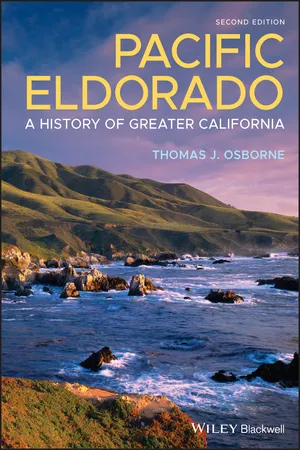
Pacific Eldorado
A History of Greater California
Thomas J. Osborne
- English
- ePUB (mobile friendly)
- Available on iOS & Android
Pacific Eldorado
A History of Greater California
Thomas J. Osborne
About This Book
The fully-revised second edition of the bestselling textbook — an original interpretation of the entire span of California history
The rich history of California can best be told through its connection with the Pacific Basin. From the geological origins of the land and its earliest seafaring inhabitants, to current economic trade relationships and remarkably diverse cultural influences, the factors that continue to shape the Golden State are inseparably linked to the vast ocean to its west. Pacific Eldorado is a comprehensive exploration of the entire sweep of California's past in relation to the maritime world of the Pacific Basin. Offering a bold and original interpretation of the history of the region, prominent historian Thomas J. Osborne enables readers to view the state's development through a Pacific-focused lens.
Now in its second edition, this acclaimed textbook reflects new scholarship, places greater emphasis on environmental topics, and examines recent California history. Designed to help students think critically about commonly-held ideas, the author challenges conventional views, such as those of pre-Gold Rush California, confronts the traditional Atlantic-centric approach to American history, and presents a new analytic framework for studying the state's past. The text enables students to understand the evolution of California, from the time of prehistoric Asian seafarers to the state's present-day position as the nation's wealthiest and most populous state. Rigorous yet accessible, this text:
- Explores a "Greater California" history that extends beyond geographic borders
- Offers new, expanded, and revised coverage of plate tectonics, the citriculture boom of the late 1800s, the environmental history of California, and more
- Features "Pacific Profiles, " brief chronicles of notable figures who have made an impact on the state's history
- Has a new feature, "Transpacific Connections" that illustrates further the fascinating ties between California and the Pacific World; for example, comparing the California gold rush to the contemporaneous New Zealand gold rush and indicating the connections between the two
- Supports a Pacific-centric approach with compelling examples, such as the building of the transcontinental railroad to increase the China trade
- Includes new and updated photographs, illustrations, maps, references, and reading suggestions
Already adopted by a wide range of institutions, the new edition of Pacific Eldorado: A History of Greater California continues to be an essential resource for students and instructors in California history courses, as well as those required to pass exams on California history and government to obtain California teaching credentials.
Frequently asked questions
Information
1
Beginnings: From Fire and Ice to Indian Homeland
Timeline
| 30 million years ago | California's land mass is formed by Pacific geological processes, especially through plate tectonic subductions and lateral movements |
| 13,000 years ago | Following the “Kelp Highway,” Asian Pacific voyagers arrive in the Channel Islands, likely becoming the first Californians, according to archeologist Jon M. Erlandson and others The Arlington Woman, so‐called by scientists, lives and dies at a site on Santa Rosa Island along California's coast |
| 10,000–15,000 years ago | As climate warming set in and Beringia melted into the Bering Strait, the descendants of Paleo‐Indian migratory hunters continue on their way eastward and southward throughout the New World in pursuit of game |
| 4,600 years ago | A bristlecone pine (Pinus longaeva), located in California's White Mountains and dating back more than four millennia, is thought to be the oldest living thing on Earth |
| 2,000 years ago | Some of today's California redwood trees, the world's largest living things, date to the time of Jesus of Nazareth and the Roman Empire |
| 1000 CE | Chumash Indians build a seafaring culture in and around today's Santa Barbara and on a few of the Channel Islands |
| 400–800 | Though questionable, early Polynesians may have reached California in watercraft, according to a very small group of anthropologists and linguists |
| 1500s | Specialists estimate that 15,000 Chumash lived in California at the time of European contact |
| Late 1700s | Between 300,000 and 1,000,000 indigenous people inhabited California most of them living in villages of 100–500 dwellers |
Landforms
